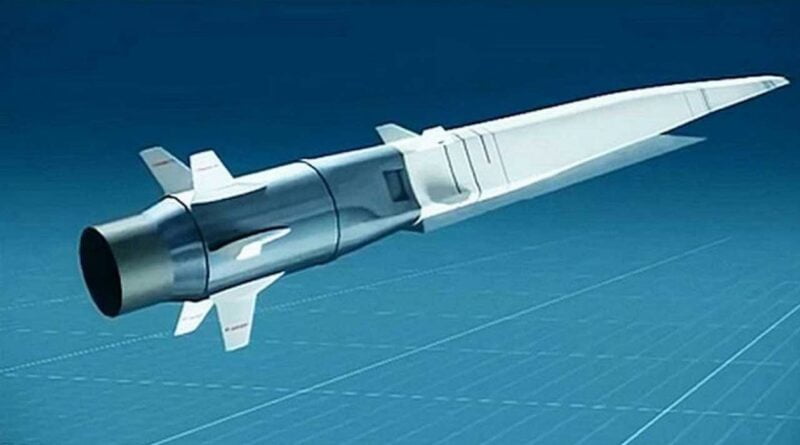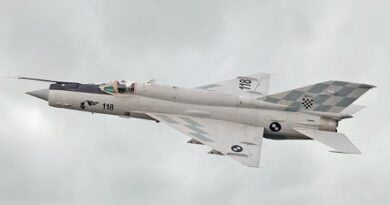Tsirkon Hypersonic Missile
Context:
Recently, Russia has fired its Tsirkon Hypersonic Missile from a warship in the north of the country.
- Earlier, it was reported that China tested a nuclear-capable hypersonic glide vehicle that circled the globe before speeding towards its target.
Contents
About Tsirkon Hypersonic Missile:
- The 3M22 Zircon also spelled as 3M22 Tsirkon is a scramjet powered maneuvering anti-ship hypersonic cruise missile currently in testing by Russia
- The Zircon missile is capable of flying 9 times the speed of sound and hit targets successfully upto a range of 1,000 kms (620 miles).
- The Tsirkon Cruise Missile will join Avangard glide vehicles and the air-launched Kinzhal (Dagger) missiles in Russia’s hypersonic arsenal.
- The missile can develop a speed of Mach 9 and fly at an altitude of 30-40 km where the range and speed increase as air resistance is smaller.
- Experts estimate the payload at 300-400 kg and the missile length at 8-10 meters.
- Tsirkon is to be fired from universal vertical launchers 3S-14 on warships and submarines and from Bastion mobile coastal missile launchers.
Hypersonic Technology:
- Speed: 5 or more times the Mach or speed of sound.
- Mach Number: It describes an aircraft’s speed compared with the speed of sound in air, with Mach 1 equating to the speed of sound i.e. 343 metre per second.
- Technology Used: Most hypersonic vehicles primarily use the scramjet technology, which is a type of Air Breathing propulsion System.
- This is extremely complex technology, which also needs to be able to handle high temperatures, making the hypersonic systems extremely costly.
- Types:
- Hypersonic cruise missiles: These are the ones that use rocket or jet propellant through their flight and are regarded as being just faster versions of existing cruise missiles.
- Hypersonic Glide Vehicle (HGV): These missiles first go up into the atmosphere on a conventional rocket before being launched towards their target.
Development of Hypersonic Technology in India:
- India, too, is working on hypersonic technologies.
- As far as space assets are concerned, India has already proved its capabilities through the test of ASAT under Mission Shakti.
- Hypersonic technology has been developed and tested by both DRDO (Defence research and Development Organisation) and ISRO (Indian Space Research Organisation).
- Recently, DRDO has successfully flight-tested the Hypersonic Technology Demonstrator Vehicle (HSTDV), with a capability to travel at 6 times the speed of sound.
- Also, a Hypersonic Wind Tunnel (HWT) test facility of the DRDO was inaugurated in Hyderabad. It is a pressure vacuum-driven, enclosed free jet facility that simulates Mach 5 to 12.
Differences between Ballistic Missile and Cruise Missile
| Ballistic Missile | Cruise Missile |
| It is propelled only for a brief duration after the launch. | Self-propelled till the end of its flight. |
| Similar to a rocket engine. | Similar to a jet engine. |
| Long-range missiles leave the earth’s atmosphere and reenter it. | The flight path is within the earth’s atmosphere. |
| Low precision as it is unguided for most of its path and its trajectory depends on gravity, air resistance and Coriolis Force. | Hits targets with high precision as it is constantly propelled. |
| Can have a very long range (300 km to 12,000 km) as there is no fuel requirement after its initial trajectory. | The range is small (below 500 km) as it needs to be constantly propelled to hit the target with high precision. |
| Heavy payload carrying capacity. | Payload capacity is limited. |
| Can carry multiple payloads (Multiple Independently targetable Re-entry Vehicle) | Usually carries a single payload. |
| Developed primarily to carry nuclear warheads. | Developed primarily to carry conventional warheads. |
| E.g. Prithvi I, Prithvi II, Agni I, Agni II and Dhanush missiles. | E.g. BrahMos missiles |
India’s Missile Systems
| Missile | Type | Range | |
| Astra | air-to-air | 80 km | |
| Trishul | surface-to-air | 9 km | |
| Akash | 30 km | ||
| Prithvi Air Defence (PAD) | 2000 km | ||
| Nag | surface-to-surface Anti-tank missile | 4 km | |
| Prahaar | surface-to-surface | SRBM | 150 km |
| BrahMos | land, naval, air | Supersonic Cruise Missile | 300 km |
| Nirbhay | land, naval, air | Subsonic Cruise Missile | 1000 km |
| K-15 Sagarika | underwater-to-surface | SLBM | 700 km |
| Dhanush | sea-to-sea/surface | SRBM | 350 km |
| Shaurya | surface-to-surface | SLBM | 1900 |
SLBM: Sub-marine launched ballistic missile
| Missile | Features |
| Astra | Astra is a beyond-visual-range (BVR) air-to-air missile (AAM).In terms of size and weight, the Astra is the smallest missile developed by the DRDO.It was envisaged to intercept and destroy enemy aircraft at supersonic speeds. |
| Trishul | Used as anti-sea skimmer (to fly low to avoid radar) from ships against low-flying attacks. |
| Akash | It has the capability to “neutralize aerial targets like fighter jets, cruise missiles and air-to-surface missiles” as well as ballistic missiles. |
| PAD | Anti-ballistic missile developed to intercept incoming ballistic missiles outside the atmosphere (exo-atmospheric). |
| Nag | 3rd generation anti-tank ‘fire and forget’ guided missile (lock-on before launch system) where the target is identified and designated before the weapon is launched. |
| Prahaar | High manoeuvrability.Primarily a battlefield support system for the Army. |
| BrahMos | It is a supersonic cruise missile developed as a joint venture between Indian and Russia.It is the fastest supersonic cruise missile in the world.It is the world’s fastest anti-ship cruise missile in operation. |
| Nirbhay | Subsonic missile which is ancillary (providing necessary support) to the BrahMos range. |
| K-15 Sagarika | It forms the crucial third leg of India’s nuclear deterrent vis-à-vis its submarine-launched ballistic missile (SLBM) capability.It was subsequently integrated with India’s nuclear-powered Arihant class submarine. |
| Dhanush | It is capable of carrying nuclear warheads.It carries forward the legacy of the K-15 Sagarika. |
| Shaurya | Surface-to-surface ballistic missile (SSM) variant of the K-15 Sagarika.The nuclear capability of the missile enhances India’s second-strike capability.It reduces the dependence on the K-15 which was built with Russian assistance. |
Prithvi Missiles
All the Prithvi variants are surface-to-surface SRBMs.
| Name | Version | Range | Payload in kg |
| Prithvi I | Army version | 150 km | 1000 |
| Prithvi II | Air force version | 350 km | 500 |
| Prithvi III | Naval version | 600 km | 1000 |
Agni Missiles
| Name | Type | Range | Payload in kg |
| Agni-I | MRBM | 700 – 900 km | 1,000 |
| Agni-II | MRBM | 2,000 – 3,000 km | 750 – 1,000 |
| Agni-III | IRBM | 3,500 – 5,000 km | 2,000 – 2,500 |
| Agni-IV | IRBM | 3,000 – 4,000 km | 800 – 1,000 |
| Agni-V | ICBM | 5,000 – 8,000 km (Testing) | 1,500 (3 – 10 MIRV) |
| Agni-VI | ICBM | 8,000 – 10,000 km (Under development) | 1,000 (10 MIRV) |
MIRV: Multiple Independently targetable Re-entry Vehicle
Anti-satellite weapons (ASAT)
- In March 2019, India successfully tested its ASAT missile.
- The ASAT missile destroyed a live satellite in Low Earth orbit (283-kilometre).
- As per DRDO, the missile is capable of shooting down targets moving at a speed of 10 km per second at an altitude as high as 1200 km.
You can find many articles on SECURITY (part of GS III) in our website. Go through these articles share with your friends and post your views in comment section.
Discover more from Simplified UPSC
Subscribe to get the latest posts sent to your email.



